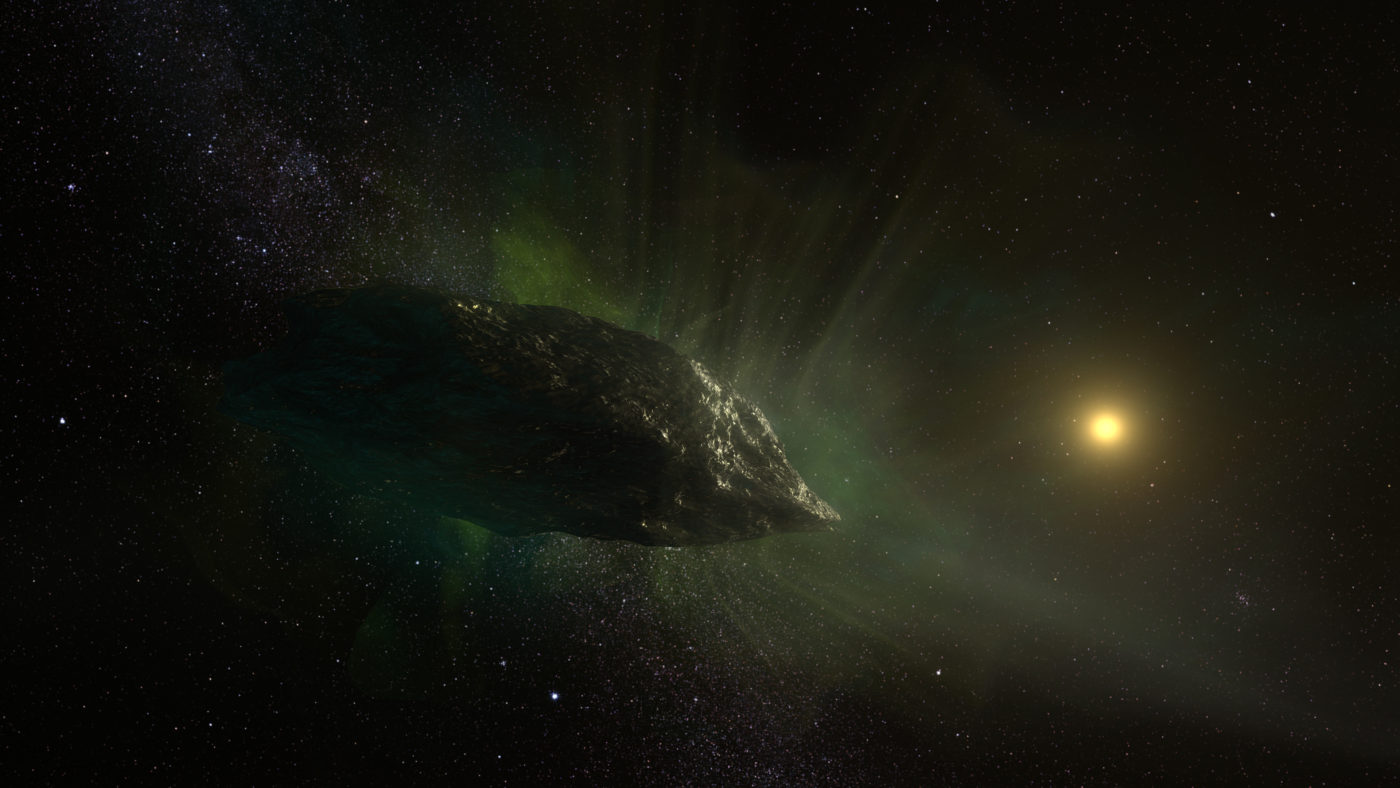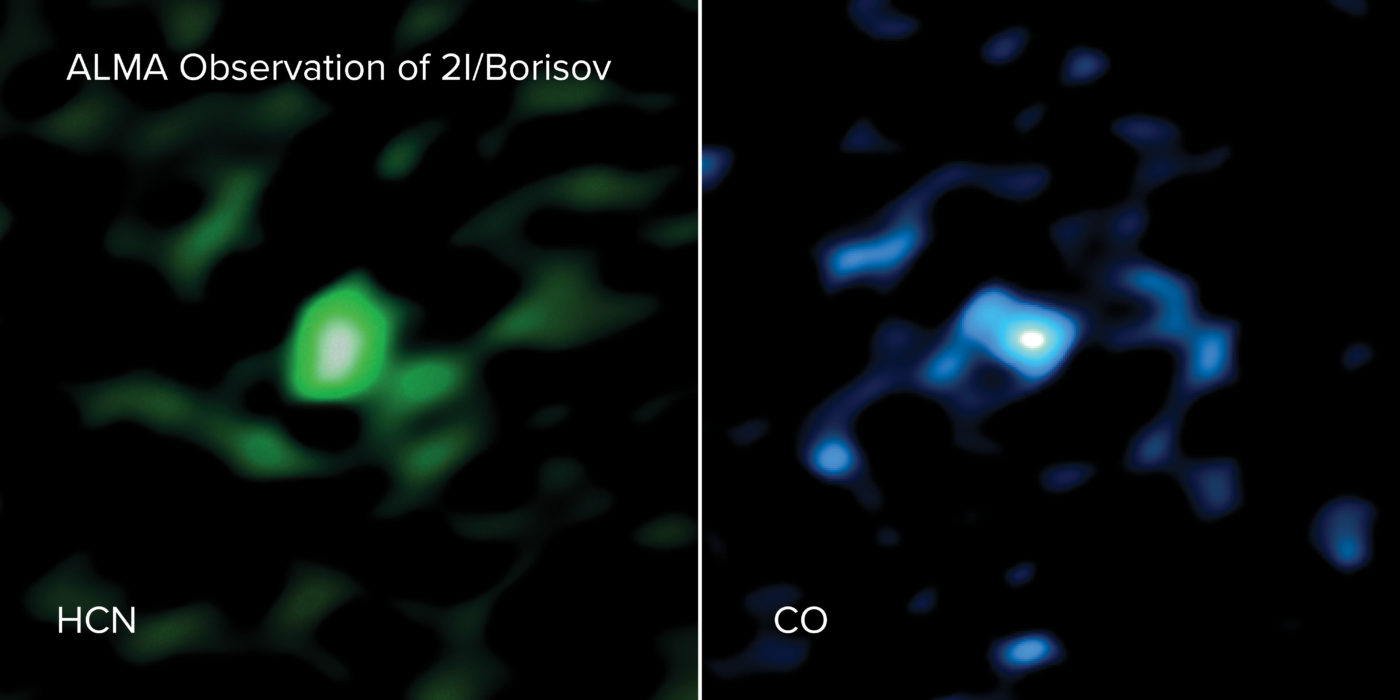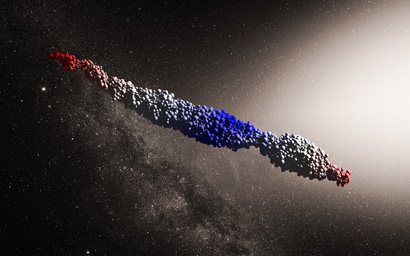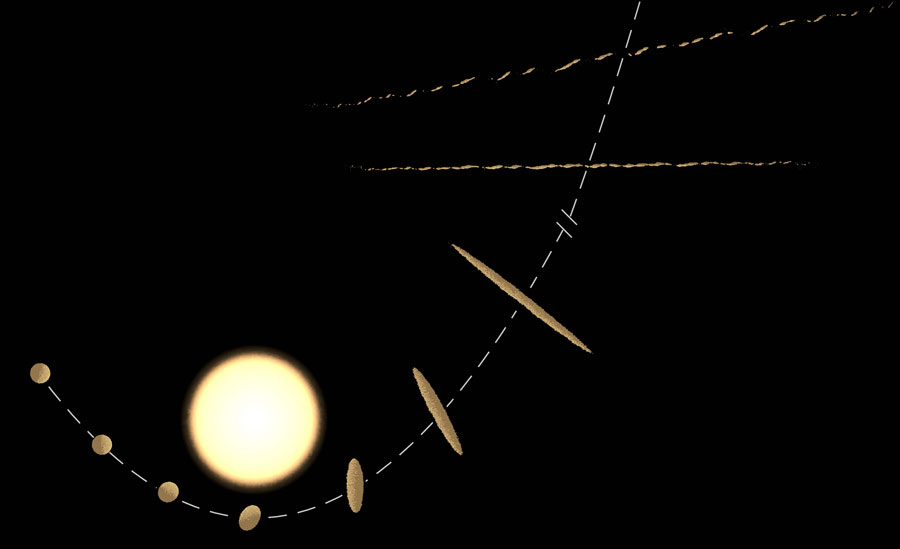The first two interstellar visitors to the solar system are finally shedding light on their places of origin.

NRAO / AUI / NSF / S. Dagnello
New ultraviolet and millimeter-wave observations show that vaporization of an abundance of primordial carbon monoxide is what made interstellar Comet 2I Borisov come alive in the inner solar system. Carbon monoxide freezes at around 25 kelvin, so this suggests Comet Borisov formed in the frosty outer fringes of its parent star's planetary disk. Separately, a new theoretical model shows how natural processes could have formed the first known interstellar visitor, 'Oumuamua.
Both objects arrived in our solar system with hyperbolic orbits, but their origins — aside from being interstellar — remained unclear. Comet Borisov is still observable, but 'Oumuamua is not, as it has now passed the orbit of Saturn on its way out of the solar system.
Where Did Comet 2I/Borisov Form?
This week's Nature Astronomy reports two studies of Comet Borisov soon after its perihelion last December, when it was bright enough for spectroscopy to reveal its composition.
Glitches with the Hubble Space Telescope forced a team led by Dennis Bodewits (Auburn University) to spread their observations of ultraviolet fluorescence from carbon monoxide (CO) over a month. Emissions from CO stayed nearly constant during that period, but emissions from water molecules dropped rapidly, initially puzzling the observers. Then they realized that outgassing had removed 1–6 meters of surface material during their observations, exposing deeper layers rich in CO. The CO levels in the coma, measured by Hubble's Cosmic Origins Spectrograph, were up to 50% higher than the water levels measured at the same time by NASA's Neil Gehrels Swift Observatory satellite.

ALMA (ESO / NAOJ / NRAO) / M. Cordiner & S. Milam / AUI / NSF / S. Dagnello
Independent millimeter-wave observations of the comet made in mid-December by Martin Cordiner (NASA Goddard Space Flight Center) and colleagues with the Atacama Large Millimeter/submillimeter Array (ALMA) in Chile also revealed an abundance of CO. The measurements showed that the amount of CO compared to water was higher than had been observed in any solar system comets inside 2.5 astronomical units (a.u., the average distance between Earth and the Sun), the so-called water snow line where water ice starts to vaporize. (Astronomers had measured higher amounts of CO in C/2016 R2 (PanSTARRS) when it was at 2.8 a.u. But Cordiner calls this Oort Cloud comet "so alien that it might be a captured interstellar comet."
Being able to measure the composition of an interstellar comet "opens up an entirely new field of planetary science — the study of remote planetary systems through direct observations of their ejected interstellar comets," Cordiner says.
The high CO levels in Comet Borisov indicate that it likely formed beyond the CO snow line, in the outer part of a planetary disk, and remained at temperatures no more than 25K during its travels through interstellar space.
Ejection from a planetary system is easy. "There are a million ways of getting rid of comets," says Bodewits. He thinks the comet may have formed about a red M-type star, where the CO snow line is only at 6.6 a.u., compared to more than 100 a.u. in our solar system.
Identifying the vaporization of carbon monoxide as the cause of Comet Borisov’s activity and fragmentation is an important addition to our knowledge of comet processes and interstellar objects, says Bryce Bolin (Caltech), who was not involved in the Nature Astronomy studies.
Making 1I/'Oumuamua
Comet Borisov was easy to recognize as a comet, but our first interstellar visitor, 1I/'Oumuamua, was like nothing astronomers had seen before. It was elongated, porous, and tumbled erratically. What's more, it moved oddly, exhibiting "non-gravitational acceleration" while releasing only wisps of gas. The object even evoked thoughts of derelict alien spaceship.

Tidal stresses: NAOC / Y. Zhang; Artist's concept: ESO / M. Kornmesser
Now, Yun Zhang (Côte d’Azur Observatory, France) thinks she has a model that "demonstrates, for the first time, that 'Oumuamua can be produced by a natural scenario based on well understood physical principles." The process, she says, "could be very common in the Milky Way."
She and Douglas Lin (University of California, Santa Cruz) describe their numerical model in Nature Astronomy on April 13th. The explanation starts during planetary formation, when a large object deflects the orbit of a kilometer-scale rubble-pile comet or asteroid, held together by gravity. The rubble pile passes within a few hundred thousand kilometers of the central star. Strong gravitational effects from the close passage stretch the rubble pile until it disrupts, in the same way that Jupiter pulled apart Comet Shoemaker-Levy 9 in a fateful encounter in the 1990s.
In Zhang and Lin's model, the disrupted pieces speed past the star, forming elongated clumps. The star’s heat vaporizes volatile ices on the surface of the elongated fragments, accounting for ‘Oumuamua’s lack of comet-like activity. However, volatiles stored deeper down, such as water, wouldn’t vaporize until the object reached the inner solar system, accounting for ‘Oumuamua’s non-gravitational acceleration.
Momentum would carry the loose structures outward, where a fraction of them would escape to roam the galaxy. The structures could be left tumbling oddly through space, like 'Oumuamua was doing when it passed through the solar system.

NAOC / Y. Zhang
If this scenario pans out, Zhang says, then ‘Oumuamua would have had its origins in the fragmentation of a comet or dwarf planet ranging from kilometers to hundreds of kilometers in size.
References:
D. Bodewits et al. “The carbon monoxide-rich interstellar comet 2I/Borisov.” Nature Astronomy, 20 April 2020.
M. Cordiner et al. “Unusually high CO abundance of the first active interstellar comet.” Nature Astronomy, 20 April 2020.
Zhang Y. & Lin D. “Tidal fragmentation as the origin of 1I/2017 U1 (‘Oumuamua).” Nature Astronomy, 13 April 2020.
 2
2









Comments
[email protected]
April 30, 2020 at 1:34 pm
Nice hypothesis, however...an elongated object was only one of the solutions to decode the brightness variations in an unresolved point of light. Everyone seems to have missed the "artist's impression" disclaimer and run off thinking that it was an actual image. Which it was not.
You must be logged in to post a comment.
Monica Young
April 30, 2020 at 3:20 pm
I believe there was some back-and-forth on the object's shape.
You must be logged in to post a comment.
You must be logged in to post a comment.